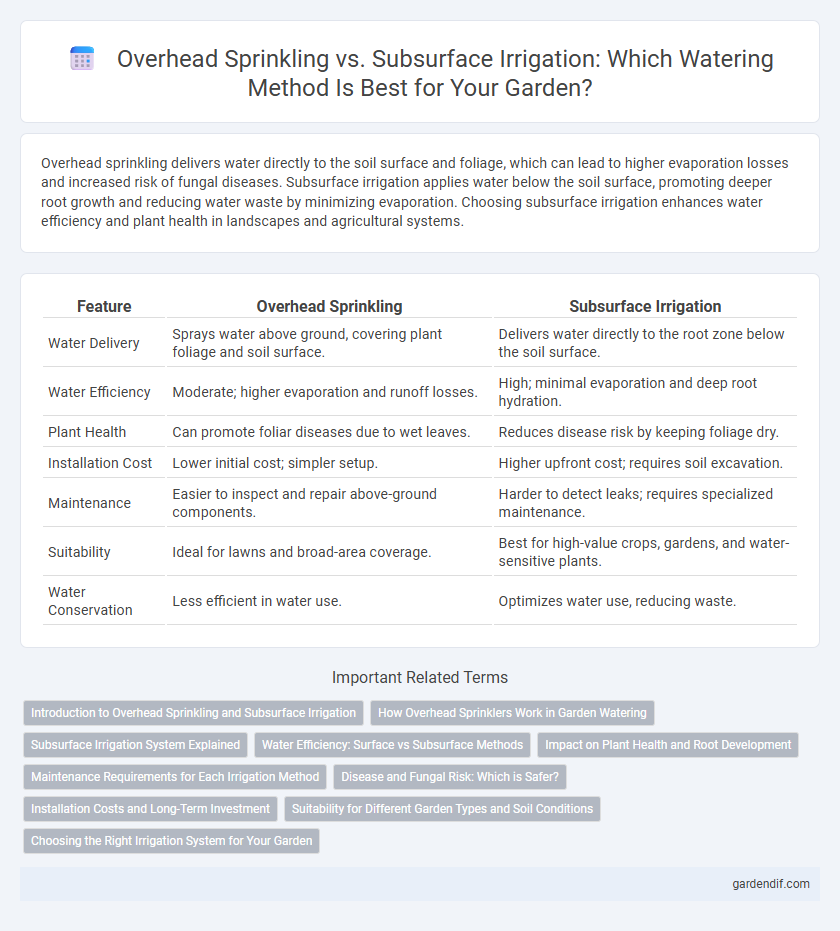
Overhead sprinkling vs Subsurface irrigation Illustration
Overhead sprinkling delivers water directly to the soil surface and foliage, which can lead to higher evaporation losses and increased risk of fungal diseases. Subsurface irrigation applies water below the soil surface, promoting deeper root growth and reducing water waste by minimizing evaporation. Choosing subsurface irrigation enhances water efficiency and plant health in landscapes and agricultural systems.
Table of Comparison
| Feature | Overhead Sprinkling | Subsurface Irrigation |
|---|---|---|
| Water Delivery | Sprays water above ground, covering plant foliage and soil surface. | Delivers water directly to the root zone below the soil surface. |
| Water Efficiency | Moderate; higher evaporation and runoff losses. | High; minimal evaporation and deep root hydration. |
| Plant Health | Can promote foliar diseases due to wet leaves. | Reduces disease risk by keeping foliage dry. |
| Installation Cost | Lower initial cost; simpler setup. | Higher upfront cost; requires soil excavation. |
| Maintenance | Easier to inspect and repair above-ground components. | Harder to detect leaks; requires specialized maintenance. |
| Suitability | Ideal for lawns and broad-area coverage. | Best for high-value crops, gardens, and water-sensitive plants. |
| Water Conservation | Less efficient in water use. | Optimizes water use, reducing waste. |
Introduction to Overhead Sprinkling and Subsurface Irrigation
Overhead sprinkling delivers water above the plant canopy, simulating natural rainfall and covering large areas efficiently but can result in higher evaporation losses. Subsurface irrigation applies water directly to the root zone below the soil surface, enhancing water use efficiency and reducing surface runoff. Both methods require tailored management practices to optimize soil moisture and support healthy plant growth.
How Overhead Sprinklers Work in Garden Watering
Overhead sprinklers distribute water through elevated spray nozzles that mimic natural rainfall, effectively covering large garden areas with uniform water application. The sprinkler system connects to a water source via pipes, pumping water under pressure to spray heads with adjustable patterns and distances, ensuring targeted irrigation for lawns, flower beds, and vegetable patches. Proper placement and timing optimize water absorption, reduce runoff, and prevent plant diseases caused by prolonged leaf wetness.
Subsurface Irrigation System Explained
Subsurface irrigation systems deliver water directly to plant root zones through buried emitters or drip lines, minimizing surface evaporation and runoff for enhanced water efficiency compared to overhead sprinklers. This method reduces foliar diseases and weed growth by keeping the foliage dry, making it ideal for landscaping, agriculture, and turf management. Subsurface irrigation maintains consistent soil moisture levels, promoting healthier root development and higher crop yields while conserving water resources.
Water Efficiency: Surface vs Subsurface Methods
Subsurface irrigation delivers water directly to plant roots, reducing evaporation and runoff, resulting in up to 50% greater water efficiency compared to overhead sprinkling. Overhead sprinkling often loses significant moisture to wind and evaporation, especially in hot or windy conditions, diminishing effective water use. Precise moisture control with subsurface systems supports healthier plant growth while minimizing water waste.
Impact on Plant Health and Root Development
Overhead sprinkling can increase the risk of foliar diseases by keeping leaves wet for extended periods, while subsurface irrigation delivers water directly to the root zone, promoting deeper root growth and reducing surface moisture. Subsurface irrigation enhances plant health by maintaining consistent soil moisture levels, minimizing evaporation losses, and improving nutrient uptake efficiency. The targeted water delivery of subsurface systems supports robust root development, resulting in plants that are more drought-resistant and vigorous compared to those relying on overhead sprinkling.
Maintenance Requirements for Each Irrigation Method
Overhead sprinkling systems often require regular maintenance such as nozzle cleaning, alignment checks, and seasonal adjustments to prevent clogging and uneven water distribution. Subsurface irrigation demands less frequent surface attention but necessitates periodic inspection of buried tubing for leaks or root intrusion to maintain efficient water delivery. Both methods benefit from scheduled system audits to optimize performance and reduce water waste.
Disease and Fungal Risk: Which is Safer?
Overhead sprinkling increases leaf wetness and humidity, creating a favorable environment for fungal diseases such as powdery mildew and downy mildew. Subsurface irrigation reduces surface moisture, significantly lowering the risk of pathogen proliferation by keeping foliage dry. Choosing subsurface irrigation enhances plant health by minimizing disease incidence and fungal growth.
Installation Costs and Long-Term Investment
Overhead sprinkling systems generally have lower initial installation costs due to simpler setup and less infrastructure, making them accessible for various garden sizes. Subsurface irrigation requires a higher upfront investment in components and professional installation, but its efficient water delivery reduces waste and lowers long-term operational expenses. Considering durability and water conservation, subsurface irrigation offers better return on investment through decreased maintenance and energy costs over time.
Suitability for Different Garden Types and Soil Conditions
Overhead sprinkling is ideal for lawns and gardens with uniform plantings and loamy or sandy soils that allow rapid water infiltration. Subsurface irrigation suits vegetable beds, flower gardens, and clay or compacted soils where deep root watering minimizes evaporation and runoff. Choosing the correct system depends on plant water needs, soil permeability, and landscape layout to maximize efficiency and plant health.
Choosing the Right Irrigation System for Your Garden
Overhead sprinkling delivers water uniformly across the garden surface, ideal for lawns and plants requiring foliar moisture, but risks water loss through evaporation and wind drift. Subsurface irrigation targets root zones directly by delivering water beneath the soil surface, enhancing water efficiency and reducing weed growth, suitable for deep-rooted plants and areas with limited water availability. Selecting the right irrigation system depends on crop type, soil characteristics, water availability, and garden layout, optimizing water use for healthier plants and sustainable gardening.
Overhead sprinkling vs Subsurface irrigation Infographic

 gardendif.com
gardendif.com